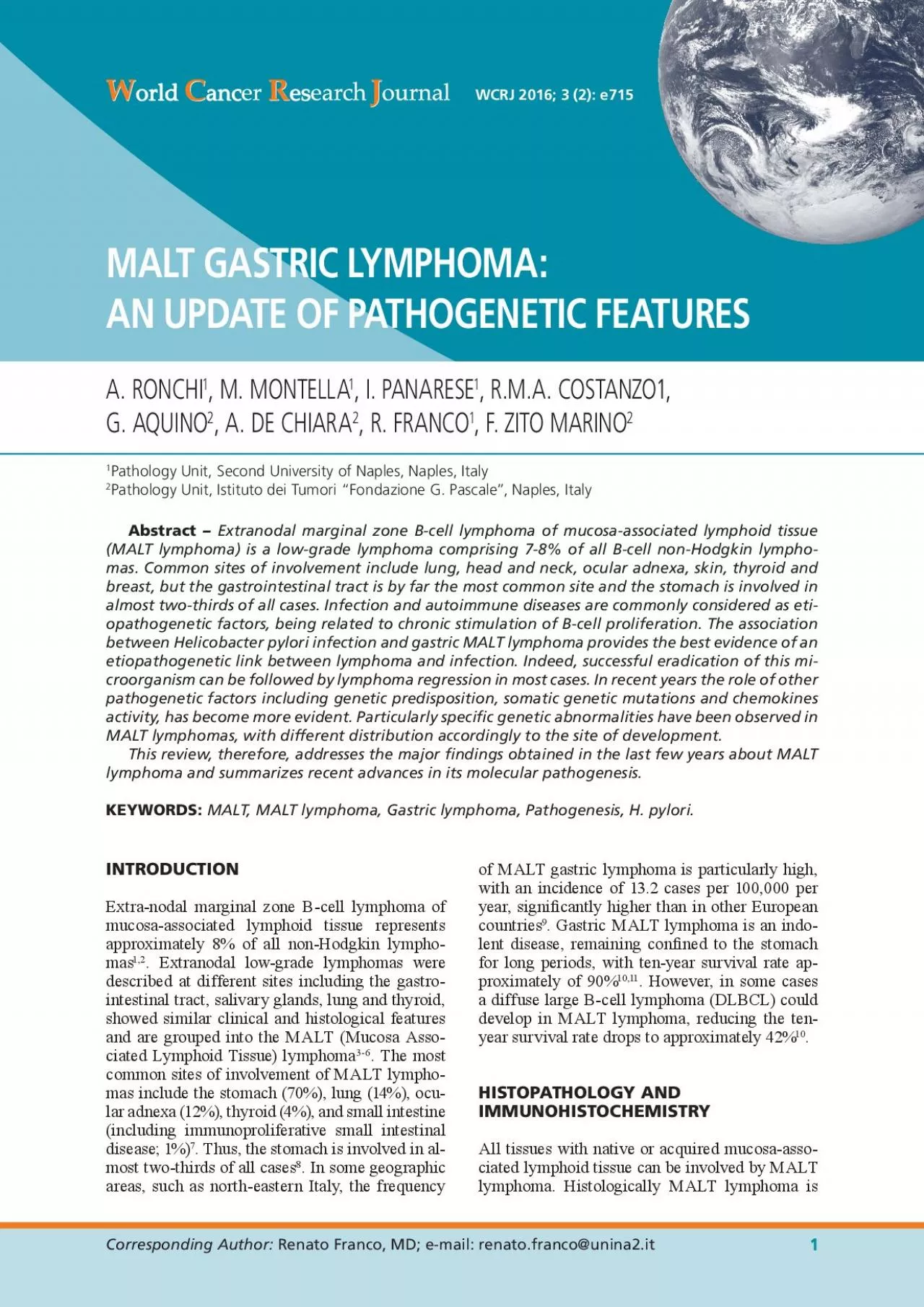

1 AN UPDATE OF PATHOGENETIC FEATURES WCRJ 2016 3 2 e715 INTRODUCTION Extranodal marginal zone Bcell lymphoma of mucosaassociated lymphoid tissue represents approximately 8 of all nonHodgkin ID: 942395
Download Pdf The PPT/PDF document "MALT GASTRIC LYMPHOMA" is the property of its rightful owner. Permission is granted to download and print the materials on this web site for personal, non-commercial use only, and to display it on your personal computer provided you do not modify the materials and that you retain all copyright notices contained in the materials. By downloading content from our website, you accept the terms of this agreement.
1 MALT GASTRIC LYMPHOMA: AN UPDATE OF PATHOGENETIC FEATURES WCRJ 2016; 3 (2): e715 INTRODUCTION Extra-nodal marginal zone B-cell lymphoma of mucosa-associated lymphoid tissue represents approximately 8% of all non-Hodgkin lympho - mas 1,2 described at different sites including the gastro - intestinal tract, salivary glands, lung and thyroid, showed similar clinical and histological features and are grouped into the MALT (Mucosa Asso - ciated Lymphoid Tissue) lymphoma 3-6 . The most common sites of involvement of MALT lympho - mas include the stomach (70%), lung (14%), ocu - l
ar adnexa (12%), thyroid (4%), and small intestine (including immunoproliferative small intestinal disease; 1%) 7 . Thus, the stomach is involved in al - most two-thirds of all cases 8 . In some geographic of MALT gastric lymphoma is particularly high, with an incidence of 13.2 cases per 100,000 per year, signi�cantly higher than in other European countries 9 . Gastric MALT lymphoma is an indo - lent disease, remaining con�ned to the stomach - proximately of 90% 10,11 . However, in some cases a diffuse large B-cell lymphoma (DLBCL) could develop in MA
LT lymphoma, reducing the ten- year survival rate drops to approximately 42% 10 . HISTOPATHOLOGY AND IMMUNOHISTOCHEMISTRY - ciated lymphoid tissue can be involved by MALT lymphoma. Histologically MALT lymphoma is Corresponding Author: Renato Franco, MD; e-mail: renato.franco@unina2.it Abstract – Extranodal marginal zone B-cell lymphoma of mucosa-associated lymphoid tissue (MALT lymphoma) is a low-grade lymphoma comprising 7-8% of all B-cell non-Hodgkin lympho - mas. Common sites of involvement include lung, head and neck, ocular adnexa, skin, thyroid and breast, but the
gastrointestinal tract is by far the most common site and the stomach is involved in almost two-thirds of all cases. Infection and autoimmune diseases are commonly considered as eti - opathogenetic factors, being related to chronic stimulation of B-cell proliferation. The association etiopathogenetic link between lymphoma and infection. Indeed, successful eradication of this mi - croorganism can be followed by lymphoma regression in most cases. In recent years the role of other pathogenetic factors including genetic predisposition, somatic genetic mutations and chemokines acti
vity, has become more evident. Particularly speci c genetic abnormalities have been observed in MALT lymphomas, with different distribution accordingly to the site of development. This review, therefore, addresses the major ndings obtained in the last few years about MALT lymphoma and summarizes recent advances in its molecular pathogenesis. KEYWORDS: MALT, MALT lymphoma, Gastric lymphoma, Pathogenesis, H. pylori. 1 Pathology Unit, Second University of Naples, Naples, Italy 2 A. RONCHI 1 , M. MONTELLA 1 , I. PANARESE 1 , R.M.A. COSTANZO1, G. AQUINO 2 , A. DE CHIARA 2
, R. FRANCO 1 , F. ZITO MARINO 2 2 ic process for the de�nitive neoplastic transfor - mation of acquired MALT in gastric mucosa 15-18 (Figure 2). H. pylori strains H. pylori is the prerequisite for gastric MALT lymphoma development. Indeed chronic antigenic stimulation causes genetic instability and clonal growth of MALT lymphoma. Additional muta - tions of tumor suppressor genes such as p53 and p16, could induce progression to DLBCL 15-18 . The role of antigen-driven clonal expansion of MALT lymphoma has been demonstrated by on - going somatic hypermutation in t
he Ig V genes 19 . Also, the Ig V gene selection in MALT lymphoma development could suggest selective pressure of an antigen to increase the af�nity of the immu - noglobulin for antigens 20 . Thus, the early stages of gastric MALT lymphoma growth may be in - duced by antigen-driven T cells speci�c for the H. pylori and the cure rate after bacterial eradica - tion is higher than 75% 21,22 . However, the role of host immune response has been not well studied, but it could play a relevant function, being only a minority of infected patients affected by
gastric MALT lymphoma 23 . Thus each H. pylori -related gastritis patients could develop gastric MALT lymphoma, but considering the very high preva - lence of H. pylori infection in the general popu - lation and the low incidence of gastric lympho - ma, it is arguable that some particular conditions characterized by marginal zone neoplastic cells diffusely in�ltrating surrounding tissues, includ - ing reactive lymphoid tissue, a process known as follicular colonization 12 . In addition, in epithelized tissue, the neoplastic lymphoid cells often in�l
- trate the epithelial structures resulting in the for - mation of lymphoepithelial lesions (LELs). Neo - plastic cells are constituted by centrocyte-like, monocytoid or plasmacytoid cells, with an ad - mixture of scattered large cells. Finally, immuno - phenotypical pro�le (CD20+, CD21+, CD35+, IgM+, and IgD−) is superimposable to normal marginal zone cells. DLBCL may be observed in MALT lymphoma, suggesting a derivation from MALT lymphoma. The demonstration of identi - cally rearranged immunoglobulin (Ig) genes be - tween the low- and high-grade components of t
he same cases seems to con�rm this hypothesis 13 . Transformed MALT lymphomas are CD10− and BCL2− but, in contrast to MALT lymphoma, they usually express BCL6 14 . Rarely, DLBCL develops in extra-lymphoid tissues in the absence of a pre - vious MALT lymphoma (de novo DLBCL), with no clinical difference with respect to ex MALT DLBCL 10 (Figure 1). PATHOGENESIS The development of MALT gastric lymphoma has been related to certain Helicobacter pylori ( Hp ) strains affecting genetically predisposed patients, suggesting the need of a strain-host-organ specif